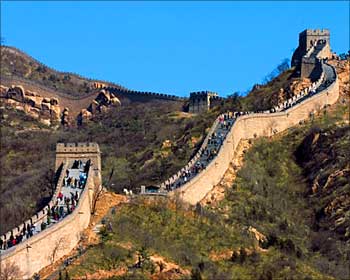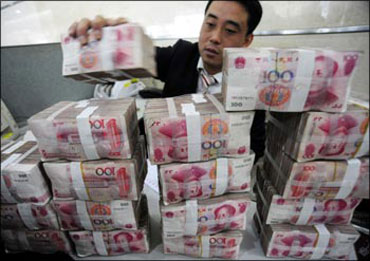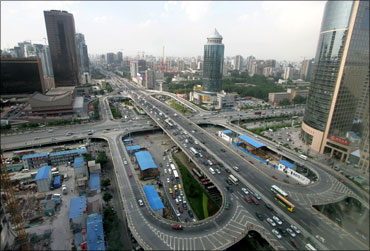
Much newsprint has been dispensed recently discussing China racing past Japan to become the world's second-largest economy.
The second quarter of 2010 saw China's gross domestic product standing at $1.34 trillion and Japan's at $1.29 trillion.
But what does this development mean for Asia and the world?
The recent numbers simply mark the completion of a trajectory that started taking shape over 15 years ago.
It is not a one-off development that is likely to be reversed anytime soon.
. . .

In terms of purchasing power parity, which takes into account the goods and services a country's currency actually buys at home, China had surpassed Japan as far back as 1995.
Back in 1995, Japan was already beginning to lose its pre-eminent position in the manufacturing world -- a trend it never quite managed to reverse.
However, at that time the Chinese economy was driven overwhelmingly by price-competitive exports, which allowed Japan to continue to dominate the high value-added manufacturing sector.
Today, though low-cost exports continue to anchor China's manufacturing sector, Chinese companies are steadily moving up the value chain.
China is now beginning to strike at the heart of Japan's competitive advantage, namely, high-end manufacturing.
. . .

The 2005 acquisition of IBM's PC Company Division by Lenovo, for example, heralded China onto the world's PC stage.
Even in automobile manufacturing, traditionally the stronghold of the Japanese (Toyota is still the No. 1 automaker in the world), Chinese players like BYD Auto are positioning themselves to be the leading players in what is largely expected to be the next wave for the auto industry -- hybrid and environment-friendly vehicles.
Established in 2003, by 2008 BYD Auto was selling the world's first mass-produced plug-in hybrid vehicle -- the same year that Warren Buffett spent $230 million to buy a 10 per cent stake in the company.
. . .

BYD is already exporting cars to Africa, South America and West Asia and has plans to enter the European, Israeli and US markets.
A planned joint venture with Daimler will focus on the development of up-market, BYD-branded sedans.
Companies like BYD have been powering growth of the Chinese economy to bring it to its current position.
Even so, the argument is often made that China's per capita GDP still lags considerably behind industrialised countries and significant intra-regional differences in per capita GDP remain in China.
. . .

This only highlights the further potential for growth in China, as well as the risks if this growth is not balanced and equitable.
What is arguably the most significant aspect of China's growth is that it has percolated down to the basic roti, kapda aur makaan level -- certainly more than in many other developing countries.
In the last 30 years, the percentage of China's population living on less than $2 a day has reduced from over 95 per cent to about 35 per cent.
Over 90 per cent of rural households in China have electricity compared to 50 per cent in India.
China's infant mortality is half of India's and average life expectancy is 10 years higher.
. . .

China's grain production stands at double that of India and the countries' population levels are comparable.
The ground that China has covered in terms of poverty reduction and provision of basic needs in a period of 30 years is astonishing.
Another unique feature of China's growth story is the role of women. China today has one of the highest participation rates of women in the workforce and an exceptionally high percentage of these women rise to senior positions in their jobs.
China's numbers on this front are not only higher than other developing countries but are also significantly higher than the US.
Whether women's involvement in the workforce is driven by China's one-child policy or is a fallout of its communist legacy, the outcome of gender-inclusive growth is a desirable one.
. . .

In fact, one of the biggest challenges that Japan faces today is how to draw women back to the workplace.
In the light of a strict immigration regulation, drawing Japanese women into the workforce is one of the last resorts for Japan to expand its working population and offset a declining birth rate and support the growing cohorts of retirees.
China's rapid growth has also resulted in growing political might and ambition.
This is natural since the UK, Germany, Japan and the US have all, at some point of time in their history, used their economic prowess to establish a political presence in the world.
This is no justification of the trend but an acknowledgement of its inevitability.
China today provides easy target practice for the rest of the world.
. . .

Politicians from Australia to the US have been quick to attribute their falling economic fortunes to China's trade malpractices.
Have those countries ever stopped to think about what their economies might look like today if China did not exist?
Though there may be much ambiguity the world over about China's emergence, the world needs China.
A manufacturing powerhouse, China's low-cost exports today are underpinning worldwide consumer spending and company profits.
Asia today may have decoupled from the West but the rest of world, including Asia, is far from decoupled from China.
The author is with Asia Society, Hong Kong